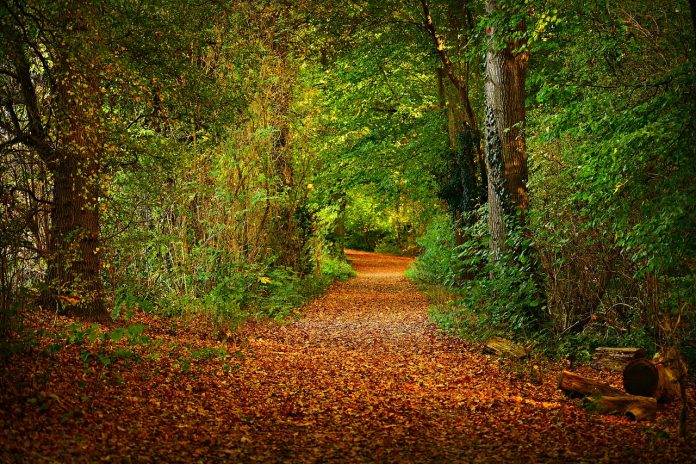Even though I love to travel and explore, I do embrace the return to routine and structure when school begins in the fall. Instead of finding new trails and exploring different places, I have witnessed the slow change in seasons on the well-worn path I take through the woods every day. A change in my attitude makes the mundane more mesmerizing.
The ground became drier and the bright summer colors transitioned to warmer hues of autumn. More spiderwebs appeared in the early morning sunlight, stretching across the stalks of weeds growing near the riverbank. Skunk cabbage was replaced with jewelweed, with many of the plants growing to almost five feet tall. A scattering of orange and yellow blooms added to the landscape.
One morning in particular I remember leaning in closely to look at the water drops clinging to the leaves and orange blossoms on the jewelweed. Powerful hydrogen bonds in water made the droplets stick together and form orbs on the dark green leaves. One singular drop hung from a delicate orange petal. It did not go unnoticed that even the smallest display of creation can be as interesting as the grandest geographical features.
Another plant with impressive water droplets was the fall sedum in my flowerbed. The thick petals created perfect valleys for the water to run together. Giant drops nestled in the space between leaves and the stem.
Better than the artwork added to a calendar could capture, a monarch flitted down to the flower. Monarch butterflies are attracted to my fall sedum every year but not for the water. They are drawn to the clusters of tiny pink blossoms which offer them sustenance in the form of nectar. The striking black and orange beauties will soon begin their migration to central Mexico for the winter.
The drop in temperature is a welcome change. Wearing long sleeves and sitting around a campfire is one of my favorite activities. I love to feel the warmth from the fire and lean back just enough to see the stars above me. I seek out familiar constellations like they are old friends in a crowd of people.
The first time I saw the Milky Way galaxy was after a long day of hiking in Zion National Park in southern Utah. Exhausted, I rested my head near the seatbelt and window. In awe, I saw what looked like a chasm in the almost black sky. The milky appearance was like a portal to deeper stars and more constellations. Pictures in science books cannot replicate the experience.
Only a couple of times on the farm have the weather conditions been perfect to see the Milky Way galaxy. After my experience in Utah, I knew what I was looking for even though it didn’t seem as clear and close. It was still impressive to see the Milky Way in Ohio; not many places can escape light pollution.
The last few weeks did provide many opportunities for moon gazing in addition to star gazing. When I heard the hype about the Super Blue Moon during the last week of August, I had to wonder, is there ever just a normal full moon? I concluded that the Super Blue Moon was definitely not overrated. The moon looked so close that I stopped in my tracks, spellbound in the bright light by the craters and valleys on the moon rarely seen without a telescope.
My two boys had many questions about another strange sight they saw in the night sky. They saw a string of lights darting in a straight line. It didn’t take long to figure out they had seen the SpaceX Starlink satellite train. We planned to see the lights again, this time looking online to find the exact time and location. Stopping along our road with wide open fields on both sides, we scanned the sky for the lights.
I was skeptical that we would see them, but my youngest son spotted them first. From the west to northeast, we watched them pass in a straight line. The satellites are easiest to see a day or two after launch. Once they reach their destination of orbiting the Earth at about 550 kilometers, they disperse and are harder to see.
The satellites provide internet service to remote areas around the globe. However, the verdict hasn’t been reached on whether or not they are completely beneficial. Currently, the number of SpaceX Starlink satellites is hovering around 5,000. The company aims to have that number reach 40,000 eventually. It has already been referred to as a mega constellation.
The skeptic in me is already concerned about how this changes the night sky and pollutes our atmosphere. Just as I was about to fall into a rabbit hole of worry, a shooting star jetted across the sky in a fraction of a second. It reminded me that I am a part of the delicate balance of creation, but not responsible for carrying the entire weight.













